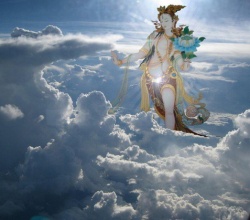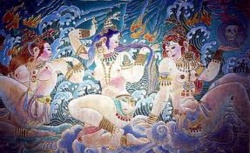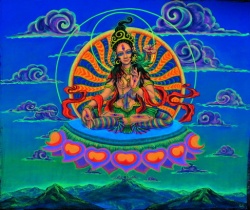Dakinis: Sky Dancers
"Dakini (Sanskrit: डाकिनी ḍākinī; Standard Tibetan: མཁའ་འགྲོ་མ་ khandroma, Wylie: mkha' 'gro ma, TP: kanzhoima; Chinese: 空行母) The dakini is a tantric figure representing a female embodiment of enlightened energy. The Tibetan form of dakini, khandroma, translates as 'she who traverses the sky' or 'she who moves in space' or, more poetically, as 'sky walker' or 'sky dancer'.
"Practices of the Wrathful Lion-Headed Dakini Simhamukha.......Generally, in terms of Tibetan Buddhism, the Dakini represents the autonomous feminine principle that is outside the control of patriarchal society and the rational male ego consciousness. For this reason, the Dakini may be represented as alluring and enchanting, but also as wrathful and terrifying.
This seminar will look at the meditations, rituals, and magical practices associated with the wrathful lion-headed Dakini Simhamukha, mistress of enchantments, sorceries, and witchcraft, who brings all those beings who are difficult to subdue under her power, and who also vanquishes and subdues all obstacles, negativities, and evil spirits. Simhamukha was the personal practice of Guhyajnana Dakini, the female Guru of Padmasambhava in the [[Wikipedia:Central Asian|Central Asian]] country of Uddiyana and he introduced the practice into Tibet. She remains a very popular practice in the Nyingmapa school of Tibetan Buddhism. For this purpose, we rely on the profound expositions of Jamgön Kongtrul, Jamyang Khyentse, and Dudjom Rinpoche regarding the practices for this Dakini, who is a manifestation of enlightened awareness.".....http://www.vajranatha.com/schedule.html
Dakinis dance and leap into the air performing acrobatic feats in a mandala on the upper floor of Jampa Lhakhang in Lo Manthang.
"Simmer-Brown (2001: p. 57) when conveying the ambiguity of ḍākinīs in their 'worldy' and 'wisdom' guises conveys a detailed narrative that provides the origin of Lawapa's name:..."worldly ḍākinīs are closely related to the māras of India, who haunted the Buddha under the tree of awakening. In this role, they took whatever form might correspond to the vulnerabilities of their target, including beguiling and seductive forms of exquisite beauty. When that ruse failed, they again became vicious ghouls and demonesses. When the yogin Kambala meditated in an isolated cave at Panaba Cliff, the local mamo ḍākinīs plotted to obstruct his meditation.
Noticing that he was particularly reliant upon a tattered black woolen blanket that also served as his only robe, they asked to borrow it. Sensing the power of the blanket, they tore it into shreds and devoured it, burning a final scrap in his cooking fire. In anger Kambala magically transformed the mamo ḍākinīs into sheep and sheared them, so that when they returned to their original forms their heads were shaven.
Fearing the power of his realization, the mamos vomited up the shreds of blanket, and Kambala collected the pieces and rewove them. From that day, he was called Lvapa, or "master of the blanket".....Simmer-Brown, Judith (2001). Dakini's Warm Breath: the Feminine Principle in Tibetan Buddhism. Boston, USA: Shambhala. ISBN 1-57062-720-7 (alk. paper): p.57
Sukhasiddhi Dakini ....instrumental in the transmission of the Mahamudra teachings, but is of especial importance to the Shangpa Kagyu lineage. She was one of the main teachers of their founder Khyungpo Naljor (khyung po rnal 'byor, 11/12th cent.).
KHYUNGPO NALJOR...(978-1127)..."In his work 'An Impartial History of the Sources of Spiritual Instruction', Jamgon Kongtrul had great praise for Khyungpo Naljor, who mastered both Ancient Tibetan lineages and had more than 150 teachers. He founded the Shangpa lineage."...(Jamgon Kongtrul's Retreat Manual..pg 87)...
SUKASIDDHI...Khyungpo Naljor considered her to be one of the greatest of his 150 teachers."..(Kongtrul's Retreat Manual..pg 86)...
Seljé Dö Drelma is the Dakini of sleep in the Bon Tradition.....She is invoked and visualized in sleep-yoga-practice in the Ma Gyu (Mothertantra)..... http://ligminchastore.org/media/catalog/product/cache/1/image/9df78eab33525d08d6e5fb8d27136e95/i/m/img_deity_card_sleepkhandro_full265px.jpg
"According to the Blue Annals, Khyungpo Neljor asked his teachings whether anyone in India had met the Buddha Vajradhāra, the source of the Buddhist tantras. They replied that Niguma, reputedly the sister of Nāropa, had done so. Khyungpo Neljor sought her out, finding her in the Sosa charnal ground in East India. He requested her transmission, to which she replied “I am a flesh-eating ḍākinī!”
When he pressed her, she demanded gold. Taking his gold and throwing it into the forest, her retinue of ḍākinī formed a maṇḍala, bestowing on Khyungpo Naljor the initiation of the Illusory Body (sgyu lus) and Dream Yoga, two sections that make up the Nigu Chodruk (ni gu chos drug), or Six Yogas of Niguma.
Niguma then transported him to a golden mountain summit where she bestowed the complete Six Yogas, the Dorje Tsikang (rdo rj tshig rkang) and the Gyuma Lamrim (sgyu ma lam rim). She prophesied that the teachings should stay secret until the seventh lineage holder, she being the second after Vajradhāra.".......http://www.treasuryoflives.org/biographies/view/Khyungpo-Naljor/6285
"Khyungpo Naljor, a twelfth-century teacher in Tibet, once had a visionary experience in which a lion-headed dakini appeared to him and sang this song about working with dakini energy. Translated by western buddhist teacher, author Ken McLeod......http://www.mahakalaradio.org/resources/prayers/the-dakini-song-of-khyungpo-naljor/.....
"Kurukulla—The Dakini of Enchantment and Witchcraft......The Dakini or Khandroma, literally “she who moves through space” or “she who goes in the sky,” is a manifestation of energy in female form. There are worldly Dakinis who are human beings such as female spiritual teachers or else witches possessing psychic powers, but also non-human Dakinis such as goddesses and nature spirits in female form.
In addition, there are Wisdom Dakinis who are transcendent or beyond Samsara and represent the manifestations of enlightened awareness in female form, such as the female Buddha Tara, or female Bodhisattvas such as Lakshmi and Sarasvati, or Guardians in female form like Ekajati.
In the Tantric Buddhism of Tibet, the Dakini embodies the Wisdom Principle of Buddha enlightenment, for which reason she is said to be the Consort of all the Buddhas. More generally, in terms of Tibetan Buddhism, the Dakini represents the feminine principle that is outside the control of patriarchal society and the rational male ego consciousness. For this reason, the Dakini may be represented as alluring and enchanting, but also as wrathful and terrifying and dangerous to men.
This course will look at the meditation and ritual practices associated with Kurukulla, the Dakini of enchantments and witchcraft, coming from the mystical land of Uddiyana, the land of the Dakinis. It is she who brings all those beings who are otherwise difficult to subdue under her power.".....http://www.vajranatha.com/schedule.html This course will survey the importance of the Dakini Principle in the Higher Tantra practice of Tibetan Buddhism and introduce some of the ritual and meditation practices connected with Dakini Yoga of Kurukulla.
For this purpose, we rely on the profound expositions of Jamgön Kongtrul and Jamyang Khyentse regarding the practices for this Dakini who is a manifestation of enlightened awareness, as well as the ritual text of the Kurukulla Kalpa.
Kun grol grags pa and the revelation of the Secret Treasury of the Sky Dancers on Channels and Winds an inquiry into the development of the New Bon tradition in Eighteenth century Tibet .... Aby Jean-Luc Achard...vajrayana.faithweb.com/Kundrol.pdf
This research explores the [[Wikipedia:Central Asian|Central Asian]] origins of the Shambhala Teachings and the region of ancient 'Shamis en Balkh' (36° N 66° E) as the 'historical' location (until the 8th Century AD) of the 'legendary' Kingdom of Shambhala....also known as 'Shams-i-Bala', (Elevated Candle) it was located in the once extremely wealthy and fertile Oxus River region of Bactria and encircled by the great Pamir and Caucasus Asia Mountains......
Tagzig Olmo Lung Ring...With Tagzig to the west, Oddiyana to the east, Zhang-Zhung to the south-east, Gandharva to the south, Airyana Vaeja to the north and Uighur/Kunlun to the north east, the legendary Balkh region was an ancient spiritual vortex, the location of a great pre-history Sun Temple and a very important Buddhist, Sufi, Dzogchen, Zoroastrian, Bon, Mithraic center...Shamis en Balkh was a wealthy and rich trading center from 5000 BC, reached it height about 2400 BC, looted and conquered numerous times, destroyed by Ghenghis Khan in 1220 AD, but was still impressive when Marco Polo visited in 1275 AD......


